Joseph Lstibrek has some excellent YouTube videos online and the Building Science Corporation has lots of his writing. You'll laught and cry and learn.
In Jan 2001 I had a REEP home energy evaluation and the home rated 77. That could be raised to 82 with a high efficiency natural gas furnace and a heat exchanger (HRV). In this scale, a home with a rating of 100 has no heating costs while a rating of 0 means that the home is expensive to heat, has cold drafts and/or has poor air quality.
Here are pictures of the electronics of induction cookers.
This is the internals of the Iwatani induction cooker. It was very dirty (oily)
after years of use in a restraunt.
This is a Kenmore drop-in induction cooker which blew within a month of our buying
it used. The first picture shows all of the circuit boards. The "filter" board takes
in 240Vac and filters it and houses the control computer.
When it failed the IGBT's and the associated recitifier blew. Replacemnt cost for
the circuit board was very high ($900) and there was no obvious evidence of their
failure - except by using an ohm-meter to identify that the parts were fully shorted
internally.
When the IGBT's blew it took a while for the circuit breaker to blow. Where the "filter"
circuit board was supposed to have 240V 20A fuses - none were installed. However, the
trace on the circuit board vapourized - causing some slight damage to neighbouring parts.
After adding a copper wire to fix the blown trace and replacing the IGBT's (purchased from Hong Kong for $8 ea) and the recitifer (about
$15 from Newark) the induction cooker worked perfectly.
Adding fuses saved the rectifier the next time (April 2022) a pair of IGBT's blew.
April 2017? - Induction Cooktop Failure again
Front left element on Power Boost the two IGBTs for that power board failed and took out the 20A fuse - but the rectifier was ok.
December 2019 - Induction Cooktop Failure again
Suddenly the unit stoped working and indicated a signaling error. The 4-wire connectors for signaling / control between the main board and the swiching boards had failing solder joints. They were likely damaged when I removed the boards for repair previously as they require a special tool to extract.
But a Samwha 25V 470 uF 105C capacitor was puffing / failing and I replaced it with a 25V 220 uF 105C part and the cooktop was working again.
December 2023 - Samsung Induction Cooktop First Failure
Our used Samsung induction range works well but we find the blue display to be difficult to read and the myraid of touch
areas to make it impossible to use without the lights on.
2023-Dec-13 the largest, front right, element stopped working and the unit was popping an error code that is not in the book.
That element would not detect pots, nor would it initiate heating. Disassembling the unit and testing the IGBTs it looked like
one had failed - however that must have been because the meter leads were not fully making contact. Both IGBTs for that element
had ~0.55V between two pairs of pins which matched new and the remaining IGBTs. The rectifier for that four IGBTs looked good
and there was no circuit board damage. It was good to see that the circuit boards were fused.
The IGBTs are IR IXGR32N60 (600V, 45A) and went out of production ~2022. The replacement is IKW50N60DTPXKSA1-ND (600V, 50A TO-247 package) which is readily available from places like DigiKey.
I replaced both IGBTs for that element, re-assembled, and everything worked as it should.
Below are pictures of the circuits boards to drive the coils and a picture of the induction coils themselves:
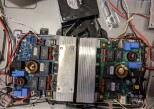
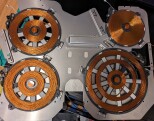
April 2022 - Induction Cooktop FINAL Failure
Front left element on Power Boost the two IGBTs for that power board failed and took out the 20A fuse - but the rectifier was ok.
Here are pictures of the induction elements - starting with a white insulation layer, a mica-like heat shield, then the coils and underneath the paramagnetic guides to keep the magnetic field right side up:
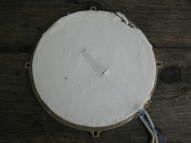
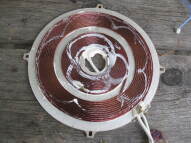
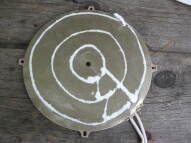
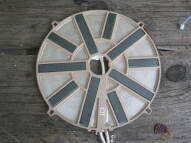
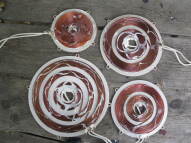
March 2011 This idea has been rattling around in my head but a re-evaluation of our gas use, for heating, has made me blue sky the idea of not having a gas fired furnace.
A more energy efficient design (smaller 2-story) with a passive solar design would require signif. less heating. Also by using annualized geo-solar to dump unused heat from a solar water heater into 100 tons of sand under the main floor would provide a lot of heat for the winter.
According to the OEB 60% of Ontario households use < 1,000 kWh per month.
There are many household items which constantly draw electricity. For example the furnace transformer
or central-vacum transformer draw aprox. 5 W of electricity all the time. Since they are rarely ever
used for most of the year they give an oportunity to save electricity.
Energy usage was measured using the watts up? standard power meter from Electronic Educational Devices INC http://www.doubleed.com The accuracy is listed as a fraction of the measured value: +/-3% +/-2 digits for loads >10W and +/-5% +/-3 digits for loads <10W. NOTE: This meter appears to be quite inaccurate for <10W loads such as switching power supplies. Ie I'll get a reading of 0W; but if I plug in another load that is about 4W and then add the one I'm trying to measure it registers 6W.
Power Measurement with Hydro Meter An excellent way to measure the power use of some things, and find vampires is to just
use the hydro meter on your house. You need to time how long it takes to do a full, or partial, revolution of the dial.
P = (3600 * dial revolutions * Kh) / revolution_time_seconds
Kh will be indicated on the meter. For low power measurements I typically count how long it takes to do 0.1 or 0.2 of a revolution
as that'll be 3 minutes! Note that the meter does become inaccurate at about 15W and less. For low power my meter doesn't seem
to turn at all.
I've used the hydro meter to measure the power use of things like the furnace fan, oven and to verify the impact of my 3 biggest vampires (microwave oven, central vacume transformer, power bar for computer and it's extras).
| Average Power Use | Load | % of total |
| Current Daily Use: 7kWh = 290W [2005] 275W [2006] average draw or $0.70/day at 0.10/kWh | ||
| 100W | estimated lighting [50W], TV for 6 hours 2008 June computer use 29.4h on, 71h standby in 10 days 2.42 kWh (63W on, 8W standby) (May 2008, 4 days, 9.3h on, 31.8h standby) | est. 34% |
| 87W | Fridge, Freezer | 30% |
| est 34+W | 3 clocks (bedroom, microwave, oven) and transformers [central vac (5W), furnace (10W * 2/3), garage door opener (4W * 1/3), answering machine (3W), furnace (10W), cordless phone (4W), attic RF tv amp (3W), tv (1W), vcr (1W)], 3 GFI sockets (??) | 12% |
| 51W | front loading washer(3W), elec. dryer(48W - rated 500kWh/yr or 57W continous) - 200 times per year | 17% |
| 23W | Computer+LCD+DSL 0.54kWh/day over 9 days Oct 2010, 2008 June computer use 29.4h on, 71h standby in 10 days 2.42 kWh (63W on, 8W standby) (May 2008, 4 days, 9.3h on, 31.8h standby) | ?% |
| guess 25W | oven - wild guess (rated 900kWh/yr or 103W continous) | 9% |
| 0W (was 25W) | 4 Smoke (now battery operated), 5W CO detector only used in winter | 0% |
Items that have been removed from electrical use:
To be removed:
Not measured:
Jan 2011 Our P4 was replaced with an older AMD 2.2GHz computer system. Power measurement is:
DSL router (6W)
old HP inkjet (6W)
older LCD standby (3W)
Computer 8W standby, 79W in BIOS, 48W typical
[2009] Our computer system (printer, DSL modem, LCD) was measured as 132W max (booting),
109W typical (114W with the LCD at full brightness) and 20W standby in Oct 2010. That
is for a P4-2.4GHz computer - all data in the table above is for a 1.3GHz P3.
Energy use was 0.54 kWh/day over 9 days (Oct 2010).
I was surprised to learn that some modern items draw as much electricity when they are off as when they are on! This typically includes printers, home stereo and VCR equipment.
Here is a list of possible upgrades:
Our oven/stove-top uses aprox $4 / month of electricity. "Self cleaning" ovens are touted as being more energy efficient because they have more insulation. They typically cost $100 to $150 more and save you 4% of your energy or about $2 per year in our case.
Office of Energy Efficiency - EnergyStar program has excellent information rating modern equipment.
Here is some of my experience with cars. In a perfect world, all cars with automatic transmissions would be banned; as well as any car that can't get 50 mpg. All monster/mini trucks, RVs, SUVs, HPVs, etc. should be crushed because of the sheer volumes of gasoline they use and pollution that they spew out. Dito for any car that can't get 45 mpg!
My home taxes are 3x more expensive than the total heating + electricity costs. This clearly means that there
is no incentive to reduce energy use!
I advocate at least a doubling or trippling of the cost of fuels [gasoline, natural gas, oil, etc] in or order
for these costs to:
1) reflect the true cost of environmental dammage / health costs associated with these fuels.
2) be a significent part of the cost of owning a home and therefore giving
home owners an incentive to reduce their consumption.
Here are some of my home energy consumption figures (old).
With the failure of nearly all window seals (15 year old Golden Windows) in our house in the first 2 months of the 2005 Winter I started looking into upgrades. Windows of our vintage used a butyl edge around the outside. It was crudely applied - rounded at the corners. With age the butyl is cracking. Note that our failed windows were on all sides of the house - some NEVER getting direct sunlight!
Windows can be upgraded (to low-E, argon, warm edge) as follows:
A typical vinyl sash is an open cavity - so for about 1" all around the window you've got perhaps R2, if you're lucky, due to the air gap and 2 vinyl layers. By filling this, even 1/2 way, with foam insulation you'll increase the R value to R4 - in excess of the R3 of an efficient glass window. Be sure not to overfill as it can warp the sash and create many problems.
The effect of low-E, Argon filling is readily measureable with a simple home thermometer. Here are some
measurements done at the centre of the window:
| Condition | Temperature Difference At Glass Between Inside Air and Glass Surface (0C outside, 20C inside) |
| Good double glazed window | reference (typically 3.5C below air temperature) |
| Failed double glazed window with misting | 0C |
| Failed double glazed window - measured where water filled | -1.25C |
| Low-E, Argon double glazed | +2.5C (typically 1.25C below air temperature 4" from window) |
| Close thick curtains | -2 to -3C |
Calculations on window energy efficiency upgrades.
| Window | Average R-value | Info |
| Vinyl Living Room double glazed, "warm" butyl seal aprox 25x20" | 1.88 (U 0.53) | uninsulated sash 1.5" wide, window 1/2" into sash 3.72 ft^2 glass, sash cavity 0.42 ft^2 + 0.25 ft^2 edges |
| Upgrade glass to low-E,argon (R3) | 3.19 (U 0.31) | |
| Upgrade glass to low-E,argon (R3) foam fill sash cavity | 3.54 (U 0.28) | sash cavity filled with foam, un-modified sash edges |
| Bedroom window (basically as above) 33x20" | 1.75 (U 0.57) | |
| Bedroom window R3 glass upgrade | 3.24 (U 0.31) | Low-E,argon glass |
| Bedroom window R3 glass & foam filled cavity upgrade | 3.56 (U 0.28) | Low-E,argon glass, sash cavity insulated |
Window stats
I started measuring PH of the wash water and detergents we use as people have implicated acidic detergents are corroding aluminum.
I've had 2 friends with failing Kenmore frontloading washers. For one the main controller (mechanical) failed and then the bearings failed. For the other the controller failed - but upon disassembly it was clear that the spider arm holding the stainless drum (aluminum spider, stainless steel drum) had cracked resulting in failure. The 2nd picture shows the back of the plastic tub where the bearings are and the drum has been grinding against it leaving plastic shavings in the tube by the pump. The drum could be pulled back and forth about 1/4" via the belt pully at the back. Mixing aluminum and steel in a wet environment like this ensures that the product will fail - and when it does it's not worth repairing.
Failures of this type seem to be all over the internet. Yes there were also 4 protruding screws from the steel drum as others have reported.
Both failed washers were around 7 years old.
Failures tend to be blamed on chemical corrosion due to the PH of the
detergent. Google "Gaute Svenningsen aluminum corrosion":
Curiously enough - I converted the four mains (120Vac) connected smoke detectors with battery operated ones and that nearly exactly balanced the increase electricity load caused by washing and drying diapers every 6 days (20W continous or 440 Wh/day). This just goes to show the power of vampire appliances when compared to legitimate use of something, a clothes drier, that is power hungry when used!
| Washer | Measured Electricity Use | Water (wash [hot] / rinse [cold] = total) | Energy Star Rating | Drier time for a typical load | Notes |
| Front Loading (Kenmore - 2002 model) | ?? w-hour | 20L / 78L = 98L | 196 kwh/yr | 60 min | regular load, high speed spin, 370W peak draw during spin |
| 128 w-hour | 20L / 92L = 112L | 196 kwh/yr | 60 min | regular load, extra rinse, high speed spin, 51 min washing time, 370W peak draw during spin | |
| Top Loading (Kenmore - aprox 1985 model) | 170 w-hour | 60L / 90L = 150L (aprox $0.25) | aprox 1,000 kwh/yr | 90 min | regular load, aprox 25 min. washing time |
This is from the Environmental Newsletter.
"Washing machines are the 2nd largest user of water in residential households. Over 20% of
indoor residential water use is for clothes washing. .. average household using a toploading
washer this represents 362 loads of laundry, 54,300 litres of water and 1,000 kW hours of
electricity per year.
(This equates to 150L/wash or $0.25 water and 3kWH or $0.40 in electricity per load.)
Efficient front-load washing machines save 40% of water and 50% of energy."
From Popular Mechanics in the USA - Electric water heaters for a family use 2,550 kWh/yr and natural gas ones use 5,774 kWh (19.7 million BTU) and fuel oil ones use 8236 kWh/yr (28 million BTU).
Details about our water heater.
Ambient 22.0C, tank top 24.5C - add 1/2" insulation tank top rises to 27.0C, 35.3C at hot water pipe under insulation, metal stud on top 40.5C under insulation
Ambient 20.7C, 39.1C at stud under insulation before furnace turned on
Ambient 23.1C, 39.1C at stud after furnace raised house 19C to 23C
Ambient 21.5C, 38.7C at stud
For my home, with natural gas heating, the hot water represents aprox 1/6 of the natural gas usage. Given that we don't use that much hot water - I find it excessive. Aprox $90 / yr in gas is spent keeping the water tank hot and about $15 / yr in heating water for use. I often leave it set at the "vacation" temperature as that is hot enough for showers and dish washing. The city is trying to upgrade me to a larger model as they claim that a 40 US gal water heater isn't big enough for 2 people - much less a family of four.
Note: The city came back with an interesting offer - a high-efficiency (96% - Polaris) water heater. Then the water heater uses an "air handler" to heat the house! It sounds good. That way we get efficient water as well as heating. The snag is that the rental costs are $37/mo much more expensive than the current water heater ($8/mo) and we'd only save $150/yr in reduced natural gas use - so it would COST us $167 / year to have more efficient heating.
Nov 2009 - In one week our 19 gallon GSW water heater used 9.31kWh or 1.33kWh/day or 55.4 W/h
Electric water heater (GSW) costs for 2006 models:
sub 40gal not-tested (ie 10L)!!
40gal 57->71 W/h
60gal 75->96 W/h
There are 3 main uses for hot water in our house:
Here is an interesting product which recovers waste heat in water and
is best used with in-line "tankless" water heaters where water is used
and dumped at the same time.
Power Pipe - Heat Recovery and
GFX Gray Water Heat Recovery and
GFX test results
These figures are from white-rodgers.com
1 Btu = 252 calories
1 Btu/Hour = 293 mW (1W = 3.413 Btu/Hour)
1 HP = 746 W
Natural gas 950 to 1150 Btu/Cubic foot (No 2 Oil is 140,000 Btu/gallon)
Butane = 3,200 Btu/Cu ft (propane 2,500 Btu/Cu ft)
So heating the water tank (33 gal in one hour costs:)
Natural gas: 33 gal * 4.5L/gal = 149 L * 50C = 29 Cu ft gas or $0.32
Electric heating: 8.6 kW for 1 hour = $1.00
During the winter of 2006 I started testing our low efficiency gas furnace. It's nameplate rating is about 75% efficiency. But that drops to an estimated 55% if it's cycled at 1F and 62% at 1C temperature swing. So I modified the thermostat by wrapping it in an insulator and then metal to add a time delay (12% longer furnace runtime, estimated 64% efficiency). Now the furnace runs 12% longer and the temperature swing is increased for an estimated 2% better efficiency. In the morning our house goes from about 17.5C to 22C and that takes 1 hour runtime and should be approaching 75% efficiency.
In December 2006 we upgraded from a low efficiency (55,000 btu, rated 76% steady state) Lennox G8 to a York (40,000 btu rated variously as 92, 92.4 94.2%) high efficiency furnace.
We're not very happy and here is why:
Our low efficiency gas furnace has a pilot light. It consumes 5.4 ccf / 30 days or 0.3 ccf/day. Our
yearly average gas consumption is aprox 1.8 ccf/day and that includes water heater.
The water heater is dominated by it's pilot light - 0.18 ccf/day (measured over a
2 minute interval) and aprox 0.1 ccf/day heating water).
That means that the furnace pilot light uses aprox 0.2 ccf/day out of 1.5 ccf/day
used for air heating or 15% of our total natural gas used for heating!!!
May 14, 2006 I measured the gas use for furnace + water heater pilot lights and got:
2/10 cu ft in 4:20 = 67 cf/day
7/10 cu ft in 19:55 = 51 cf/day
9/10 cu ft in 30:20 = 43 cf.day
Since the water heat itself draws 18 cf/day the pilot for the furnace is aprox. 25 cf/day
This clearly means that we can increase our furnace efficiency by about 15% ($80 / year estimated by actually $50 / year because we turn the pilot light off for 4 months of the year) by having an electronic ignition!
Our total gas consumption is 500 to 600 ccf per year for a family of 2 with 2 preschoolers. That breaks down to about 80% for the furnace and 20% for the water heater.
Analyzing summer consumption; in years when the furnace pilot light was turned off, and by measuring the water heater pilot light directly, I was able to breakout the following:
| Item | Gas Use ccf/day, ccf/mo | Comments $1.1c/cf |
| Summer water heater total | 0.21, 6.3 | pilot + heat, $84/yr |
| Water heater pilot light | 0.18, 5.4 | $72/yr, standing pilot light, keeps tank warm |
| Calc. water heater heating water | 0.03, 0.9 | $12/yr |
| Summer water+furnace pilot lights | 0.50, 4.5 | $201/yr |
| Calc. furnace pilot light | 0.29, 8.7 (measured aprox 0.25) | $116/yr (15% of furnace use) |
| Total House Use | 1.8, 54 | Estimated from a 2003 winter, heating house all day for kids, $723/yr |
| Calc. furnace heating house | 1.59, 48 | $638 (85% of furnace use), heating runs 8 months/year, 412 hours Dec19-May 10 |
Here is raw measurements and calculations of our furnace runtime:
Warmup: (min) 2.34 Assume all energy in warm-up phase is lost, 5 sec ignition delay Base Efficiency 76% 41,800 Btu/h output 55,000 Btu/h input Delta T Run Run/Min Effic. Net Fuel Delta Comment (C) Time Lost Effic. Wasted Loss 0.56 6.21 11.2 27.3% 55.2% $123.07 1 deg F estimate 1 11.17 11.2 17.3% 62.9% $77.83 $45.24 2 23.06 11.5 9.2% 69.0% $41.40 $36.43 3 34.59 11.5 6.3% 71.2% $28.47 $12.93 Est based on 2 Deg measurement 5.5 61.17 11.1 3.7% 73.2% $16.56 $11.92 1.12 12.48 11.2 15.8% 64.0% $70.96 Insulated thermister Try to verify eff. change by comparing 2 vs 1 Deg run times - should have lower run time (of total time?)?? Modified thermostat on Jan 14 with 12% longer run time by adding thermal mass and insulating thermostat Thermostat Runtime Totals - note counts 2.25 min warmup, not 1 min. cool-down Run time per 1C 13.62 Run time/1C modified 14.92 (furnace thermostat modified)
Kitchener Utilities says (April 2005) that the average house uses 2,600m^3 per year. Our
consumption is around 1,500 m^3/year.
Natural gas was $0.10 per m^3 upto May 1999, peaked at $0.27 in winter 2001 and fell to $0.15
in the summer of 2002 and then followed an upward trend to $0.27 in 2004. Delivery charges add
aprox $0.11 per m^3.
This heating budget is from our Home Energy Evaluation:
First a general note about low flush and dual flush toilets. Generally they have much less water in the bowl. This means that more frequent cleaning is necessray and if anything is left in the bowl when you go on vacation the water will go stagnant very quickly.
In August 2006 we acquired a dual flush (4L/6L) Vortens RF/DF toilet and there is much that we like about it. The 4L flush is almost as good as our old 6L toilet (one of the worst rated toilets at 150g/flush) and it'll flush everything pretty well all of the time - leaving a little behind some times.
We generally like the Vortens toilet - the flush knob is a bit odd and hard for our preschoolers to push - but it's better than the dual flush toilets which have the buttons on the top. It does hammer the water lines a bit when it finishes refilling the tank but otherwise was trivial to install. In over a month of use I've never had an occasion to use the 6L flush.
Our "Orion" 6L low flush toilet was installed around 2000 and it's been problematic. The flush quality is poor in general and I would never recommend this toilet, or ones rated the same, to anyone.
Have you ever considered a waterless toilet? If you are considering a low flush toilet I'd highly suggest that you only consider models tested and approved by the City of Toronto. The Waterloo Region water web site has compiled some water test results and the Seattle on in particular shows no correlation between toilet price and performance. Click on "residents" on the left and then on "toilet replacement program" and look for the link called "toilet testing".
| Kit Utilities Average Use (Sept 2006 flier) Per Person | Our Use (2 Adults, 2 preschoolers) | |
|---|---|---|
| Water Use | 215L/day/person | 130L/day/family of 4 |
| Toilet | 29% | 50L |
| Clothes Washing | 21% | 25L |
| Faucets | 16% | L |
| Shower | 13% | 25L |
| Leaks | 10% | 0L |
| Water Softener | 8% | 12L |
| Bath | 2% | ?L |
| Dishwasher | 1% | 10L |
| Cooking, Drinking | ? | 6L |
Note that if we took the greywater (shower, sink, bath, faucets) it would be more than enough to provide water for our 4L flush toilet or even a 6L toilet.
September 2006 - the average water use in our region is 215 L / day / person. The pie chart says that water use is 1% dishwasher, 2% bath, 8% water softener, 10% leaks, 13% shower, 16% faucets, 21% clothes washing, 29% toilet.
March 2005 - water rates are raised from $1.774 / m3 to $2.09 and this is apparently an increase of $6 to $7 for the "average" household. That means that the "average" family uses 20 m3 / month which is a good 5x what we use with our kids in cloth diapers that we wash at home!
While taking a shower I use 5 to 7 litres of water per shower while a more typical person is around 20 litres. I can cut my usage of water to 3.5L by turning off the water while lathering. To put this into context - a low flush toilet uses 6L and older toilets use > 12L per flush!! Having a shower daily means that 10% of my total water usage is consumed with showers.
A side effect of my water consumption is that I use so little water showering (1.5L/min or 0.35 US gal/min) that no in-line or "tankless" hot water heaters would not turn on as they all require 0.66 to 0.75 gal/min!
| Country | Annual per capita water use m^3 | Water cost per 1,000L |
| Denmark | 225 | $2.70 |
| United Kingdom | 230 | $1.65 |
| Germany | 560 | $2.70 |
| Canada | 1,600 | $1.00 |
| Our Household Family use | 50 | $1.00 |
| United States | 1,900 | $0.75 |
| Fall 2005 Kitchener Environews Flier | ||
Just how is water in our household used? Useage was 26 cubic meters / yr when I lived alone and that rose to 40 cubic meters / yr with 2 of us. Now - with twins and washing diapers every 2 days that is aprox 80 cu. meters/yr. However, once we purchased a front load clothes washer and the diaper washing was reduced to weekly our water consumption droped back to 50 m^3 per year.
The Canadian average is 326L / person / day of which 1/3 is used by toilets.
I strongly recommend flourscent lighting for areas where the lights are being used
more than 1 hour / day. The Philips Marathond flourscent lamps in particular give
a soft white light that is flicker free. The bulbs are expensive but will reward
you with a reduced electricity bill.
The compact flourscent lamps don't use the old style of transformer
to generate the high voltage but instead use an electronic circuit and much
higher frequency. For that reason they can't flicker and are much more efficient
than the old style flourscent lamps. You get what you pay for in the sense
that lower cost compact flourscents have a shorter life and are less efficient.
Lamp Electricity Use and Car Emissions Measurements
My wife and I generate one bag of garbage
every 4 or 5 weeks and fill the recycling box every 6+ weeks. The recycling
box is primarily filled with unsolicited newspapers and filers. Boxboard
[cerial boxes] and 2L pop bottles make up a small part of the material and
we almost never use metal cans.
The non-recyclable garbage which we produce is primarily wrapping from
items (food, etc) which we purchase. We compost what things we can.
A typical lawn mower puts out as much pollution as a car. Why? There is no pollution control equipment, poor control over the fuel mixing and a basic design (2 stroke) that burns oil.
I've recently bought a Yard Works "reel" lawn mower. This is the old style
of push mower that literally cuts the grass. Cutting blades virtually cut the grass
like scissors. The Yard Works mowers are made in China. German made ones
such as Gardina are about 2x the price, lighter and probably much better made.
Gardina does make an electrically powered push mower. I still go into laughing fits
when I think of it!
Problems: The reel mower did not come with lock washers and so I had to add them
and the parts were not manufactured well. In particular the arms for the handle
were not well bent and most importantly, the cutting blades were not well aligned.
If I adjust the cutting bar such that the mower cuts in the middle; the outer
2 or 3" at each side does a poor job of cutting. Moving the cutting bar more will
make the mower do a better job of cutting; but it also makes it noiser.
Here are graphs of our home energy and utilities usage:
Utility Their My
Average Use
Elec $717/yr $200/yr
Gas $700/yr $500/yr
Worse yet; they assume that hot water heating consumes 1/3 of the
natural gas consumed!!
My calculations show summer use = 13 ccf [water heating]
winter use = 93 ddf [furnace + water heating]
Therefore space heating consumes 7x more natural gas than the water heater!
Basically, their pie charts for energy usage are totaly useless given
how far their average home deviates from mine.
Be sure to point that out to them and pre-calculate some of your own
usage figures to see if they're even close to your actual consumption!
Their pie chart included:
Average My
Home Home
Space heating 49% 60%
Hot Water 28% 12%
Electricity 22% 28%
------ -----
$1410 $700 [per year]
5.3 air changes per hour "tight"
$500 [59100 ft2 / year for nat.. gas [$90/yr for water heater]
$18/mo [200 kwh] 1/3 = freezer + fridge
Fall 2001 - switched to compact flourscent lights in regularily used lighting fixtures.
Summer 2005 - switched T12 fluorscent lights to T8 and cut most fixtures from 4 or 2 lamps to 1 or 2.